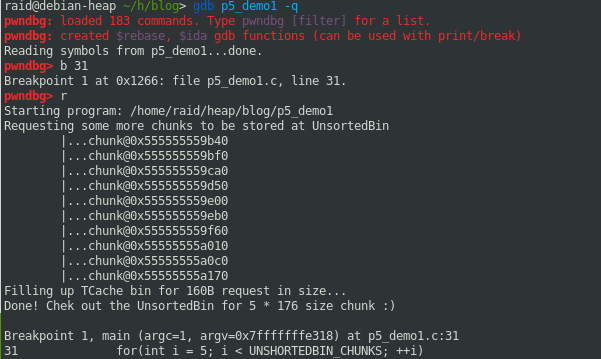Heap Series: 5/5 Heap basics from a practical perspective
In the previous part, we talked about the TCache and FastBin freelists, by making use of a couple of code-samples that would make some memory allocations and allowed us to see how the heap management was taking care of the frees and mallocs performed.
In this part, we will talk about the unsorted, small and large bins. We’ll go through some samples to verify our assumptions and make sure that everything is understood :)
Let’s dig once again into heap’s internals!
Bins
UnsortedBin
Here’s where all the rests from splitting chunks and returned chunks end up. Unless they’re “stored” at Fastbin or TcacheBins.
This structure acts like a queue where chunks are placed when freed and retrieved from when mallocated (is that even a word? o_Õ).
Weird and probably confusing description taken from the GLIBC comments, so let’s take a look:
p5_demo1.c
1
2
3
4
5
6
7
8
9
10
11
12
13
14
15
16
17
18
19
20
21
22
23
24
25
26
27
28
29
30
31
32
33
34
35
#include <stdio.h>
#include <stdlib.h>
#define MAX_TCACHE_SIZE 7
#define UNSHORTEDBIN_CHUNKS 10
#define UNSORTED_CHUNK_SIZE 160
int main(int argc, char **argv) {
void *chunks_at_tcache[MAX_TCACHE_SIZE];
void *chunks_at_unsortedbin[UNSHORTEDBIN_CHUNKS];
for(int i = 0; i < MAX_TCACHE_SIZE; ++i)
chunks_at_tcache[i] = malloc(UNSORTED_CHUNK_SIZE);
printf("Requesting some more chunks to be stored at UnsortedBin\n");
for(int i = 0; i < UNSHORTEDBIN_CHUNKS; ++i) {
chunks_at_unsortedbin[i] = malloc(UNSORTED_CHUNK_SIZE);
printf("\t|...chunk@%p\n", chunks_at_unsortedbin[i]);
}
printf("Filling up TCache bin for 160B request in size...\n");
for(int i = 0; i < MAX_TCACHE_SIZE; ++i)
free(chunks_at_tcache[i]);
for(int i = 0; i < UNSHORTEDBIN_CHUNKS - 5; ++i)
free(chunks_at_unsortedbin[i]);
printf("Done! Check out the UnsortedBin for 5 * 176 size chunk :)\n");
for(int i = 5; i < UNSHORTEDBIN_CHUNKS; ++i)
free(chunks_at_unsortedbin[i]);
return 0;
}
Good… fire up GDB set a breakpoint at line 31, and let it run.

[…]

Noice, we hit the breakpoint as expected. Let’s inspect the heap, focusing on the UnsortedBins:

Right… so it seems to have one single chunk of size 0x371 (in-use bit set, so it’s 0x370 in fact). If we follow the code, we have already freed up 5 chunks of size 160B, well at least that’s the size we requested… However keep in mind that the heap is 16B aligned for 64bit arch and that we need some extra space for the metadata thing we talked about in previous posts.
Therefore we need another two 64bit pointer at the top of our memory allocation, which turn out to be 8B each for a 64bit arch, thus making 160B + 16B = 176B.
Given that we already freed up 5 the total coalesced size of the UnsortedBin’s chunk size should be 176B * 5 = 880B. Which in hex is 0x370. Yay!
SmallBins
There’s 64 of these. FIFO, and keeping same size chunks on each. These are represented as double-linked lists, where a chunk keeps a pointer to the next and previous chunks.
However, only 62 are usable, given that Bin 0 does not exist, and the Bin 1 is the unsorted list.
The insertions are made at the head part of the list, and removals at the tail thus the FIFO behavior.
These keep chunks of size under 512Bytes on 32bit and under 1024Bytes on a 64bit architecture. See some GLIBC code ;) where the macro in_smallbin_range is defined.
As we can see, they will overlap with FastBins at some point. But that’s because the Fastbins, TCache and UnsortedBins are regarded as an optimization layer present at the heap manager. That way a memory allocation that should go to the SmallBin once freed, ends up at the TCache because the cache is not full yet.
Instead of keeping the chunks allocated (that means the P bit set at the size field), the chunks that end up in the SmallBin may be coalesced if stacked together with some other chunks. That way, the heap manager prevents fragmentation of the heap, and makes use of that coalesced space to serve further malloc requests, instead of asking the SO for it.
We’ve seen how the coalescing works at the previous demo ;) where the 5 chunks are added to conform a new bigger chunk.
LargeBins
Small, fast and tcache had something in common: They all keep bins of an specific size for many different chunk sizes.
This is pretty convenient, however is not practical when big allocations are requested. Unfortunately, the heap manager cannot have a bin for every malloc size in the devs mind.
Once the 512Bytes (for 32bit) or 1024Bytes (for 64bit) limit is exceeded, the new allocations are served (if chunks available) and stored, once free, from the LargeBins.
The LargeBins behave on a very different manner. They’re not sorted by size. But by range of sizes. Therefore, different size chunks may end up in the same LargeBin if they’re within the same size-range.
There’s 63 LargeBins, and given that the insertions are sorted by size, and removals require to traverse the whole list looking for a chunk of the desired size, makes them slower than the Small/Fast/TCache bins.
As explained at GLIBC source, the LargeBin structure looks like this:
32 bins of size 64
16 bins of size 512
8 bins of size 4096
4 bins of size 32768
2 bins of size 262144
1 bin of size what's left
Which means that there’s 32 LargeBins separated by 64Bytes each, 16 with a 512Bytes separation, 8 with 4096Bytes of separation… etc.
A really good picture of how the LargeBins structure is actually presented is the one available at this article by Azeria Labs. These articles are part of the references so make sure to check ‘em all!
This will be the last part of this series but not the last of heap related stuff, that’s for sure :) This was just the beginning of a weird journey into the heap internals.
